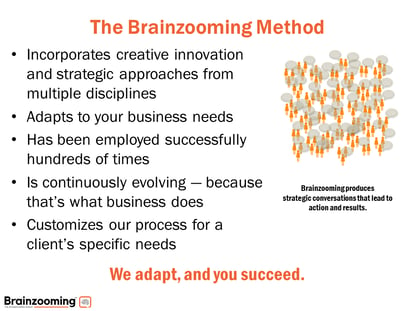What are smart ways to customize strategy planning collaborations to address an internal or external client’s specific situation?
A Brainzooming reader asked this question. I love the opportunity to answer it since customizing strategy planning for a specific organization’s situation is what Brainzooming is all about.
9 Opportunities to Customize Strategy Planning
Here are nine customization opportunities, both for the overall process and for specific strategy collaborations. Brainzooming uses all of these to streamline strategy planning, accelerate the process (by up to even 80%), and create ready-to-implement strategies.

Customizing the Strategy Planning Process
1) Solicit process-related input to identify the best and most productive approaches.
An online search suggests that there are typically between four and ten steps in strategy planning processes; five and seven steps are particularly popular. At Brainzooming, we favor three BIG steps. No matter the number of steps, there are many opportunities to customize the activities within strategy planning. Select what will be most productive by looking backward (to see what’s worked) and forward (to speculate on what’s needed in the future) for customization possibilities.
2) Include only the steps needed to update the plan.
We’re big proponents of using what a client already has prepared for strategy planning that’s still relevant and where the client feels good about the work. Most consultants I worked with when I was on the client side didn’t like doing that. Saving time and steps through incorporating great existing work is an excellent customization move.
3) Vary the initiative prioritization framework for critical success factors.
Choosing which initiatives to prioritize is a big deal during strategy planning. Customizing the prioritization approach sets the stage for helping a client settle on the most impactful activities. We customize within a four-perspective framework that pairs off Benefits and Cost-to-Implement, plus Strategic Fit and Implementation Ease. We place an exercise early in the planning process to help clients customize the factors within each perspective.
4) Design the final plan structure and format to match what the organization is best prepared to implement.
One of the first questions that I ask a client is what type of plan format that they have most successfully implemented before. If there’s a look and level of detail that works for the client, we’ll fit what we do into that structure. Ultimately, a plan is a vehicle for strategic communication, alignment, resource allocation, and implementation management. Customize the format to what will work best within the organization’s culture to turn strategies into action.
Customizing Strategy Collaborations
5) Design collaborative strategy agendas based on current opportunities and challenges.
We identify upfront, through executive input and research (both primary and secondary), what the organization’s biggest possibilities and problems are during the strategic plan’s time horizon. Distilling all that input leads to customizing a strategy meeting and its agenda to prioritize the most beneficial exercises for collaborative input.
6) Create roles for participants to help accomplish collaboration goals.
Customizing participant roles is something that Brainzooming frequently does to deputize informal small group facilitators. Giving certain participants roles to carry out (which we typically don’t disclose to everyone) customizes the experience for them and for everyone else participating.
7) Develop or adapt strategy exercises to fit a client’s culture and meeting dynamics.
There are war horse exercises that show up in nearly every strategy planning process that Brainzooming designs and facilitates. We’re always looking for tweaks to make, though, that will increase the relevance for every client’s situation. For even deeper customization, we’ll create new exercises that fulfill requests to generate unique thinking from a team that’s used to looking at things in familiar ways.
8) Translate the entire approach to the collaboration environment.
Exercises work differently when participants are in-person or online. Hybrid strategy collaborations are even more complex to manage. It’s essential to customize how you approach exercises based on the audience composition and their locations. If you want more detail on our thoughts on this, grab a copy of the Brainzooming guide to productive and fun strategy planning.
9) Manage the time of any strategy collaboration relative to the group’s progress in advancing strategy development.
No matter the venue, we time strategy exercises to create energy and provide movement throughout the agenda. Both the time I tell people they have originally on an exercise and how long I really give them (yes, those two times don’t always match!), are customized throughout a collaboration. While you can plan for the expected times, you’ll need to customize the actual times as you go based on the velocity and output from participants.
Want to learn more about customizing strategic planning?
Book a quick chat with me. Making strategic planning productive and valuable is a passion of mine (since I don’t have a lot of hobbies)!
I’d welcome sharing ideas with you on what works to help you deliver more impact from your next strategy plan. – Mike Brown




